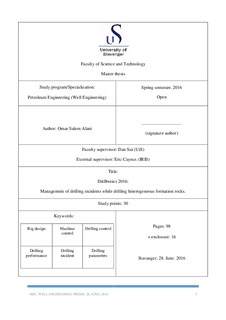| dc.description.abstract | The purpose of the thesis is to analyse the abnormal incidents on the drill pipe. The reason for this research is to apply the learned theories into the reality by building an automated rig and detect the problems. Also, to participate in Drillbotics competition 2016. Drillbotics 2016 is an international competition arranged by Drilling Systems Automation Technical Section (DSATS) that is a part of the Society of Petroleum Engineers (SPE), to encourage students to build a small and fully automated rig to drill safety and efficiency a rock sample as vertically and fast as possible. Using literature backgrounds of circumstances combined with theories makes it easier to get an estimated overview of the failures that might occur while applying different drilling parameters. Moreover, which parameters used in term of drilling to drill more safety without failures. The analysis that performed based on the design such twisting, buckling, vibration and leakage, and overpressure testing. Optimising the rotational speed and weight on bit applied; reduces problems such twisting, buckling and vibrational movements. The choice of the rotational speed and the weight on bit is based on the type of drill pipe materials which is the weakest component of the drill string, with respect to the maximum yield and ultimate torque of the drill pipe material. The next step is to build the design and see if it is working properly with the chosen values. Tests like leakage, overpressure, and over-torque performed after calibrating the load cells to evaluate the reaction of the real-time controller, to be able to stop the rotation in case of: - Low circulation pressure, leakage - High circulation pressure, overpressure - Over-torque, sticking Later buckling tests by applying weight on the 2.2 0 mm thick and 1 m long pipe, to determine the maximum weight that buckles the pipe. In the end, vibrations are observed after rotating at 180 rpm. The rig design is working fine and safe in term of torque, buckling and circulation system, but there are quite high vibrations that made it difficult to read the signal from the accelerometers. | nb_NO |
